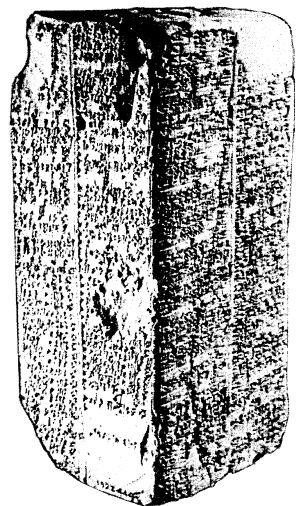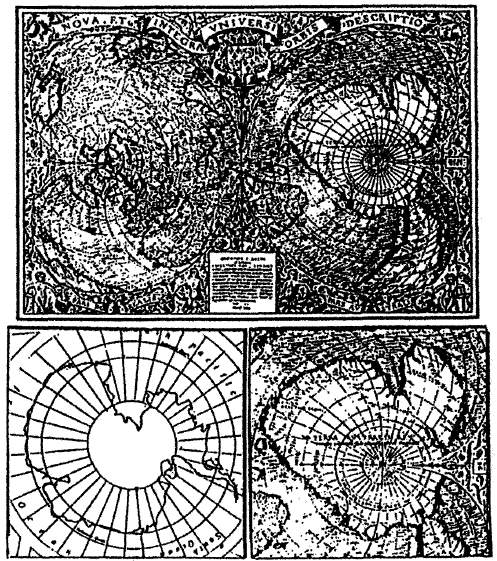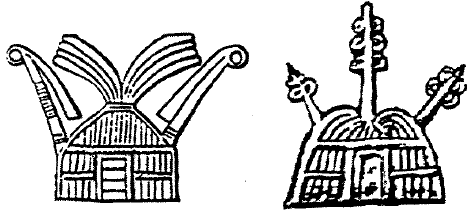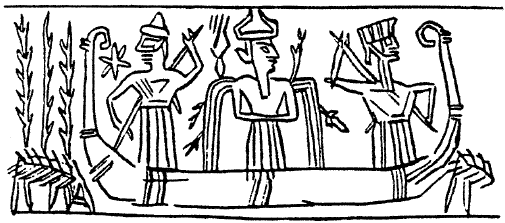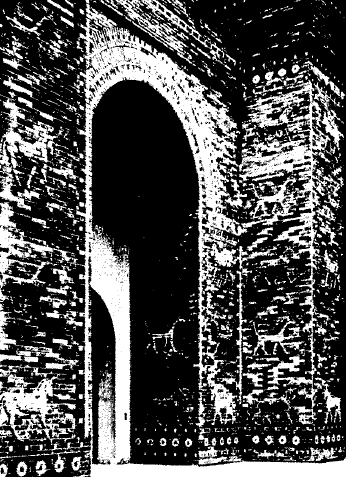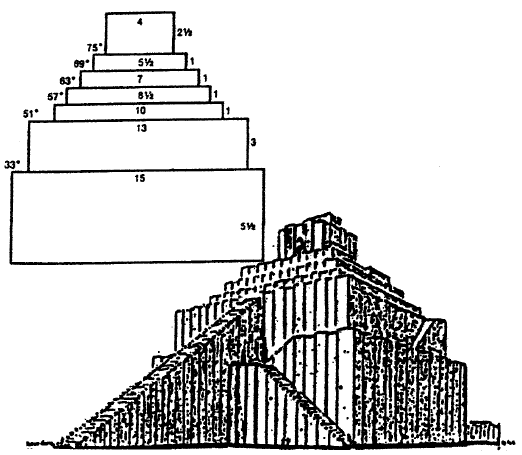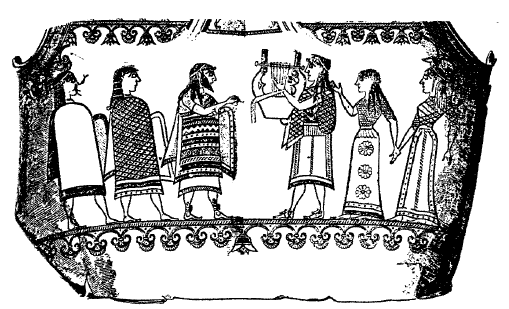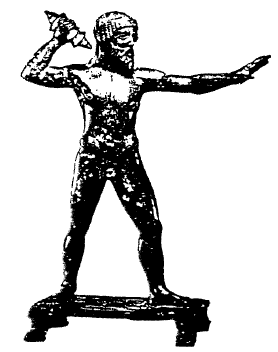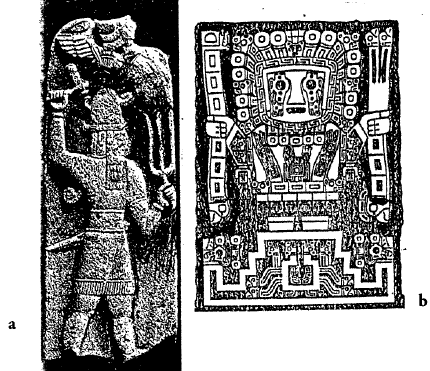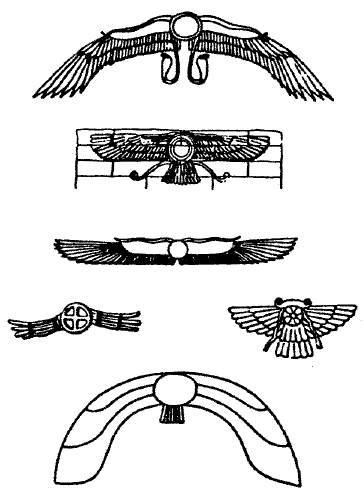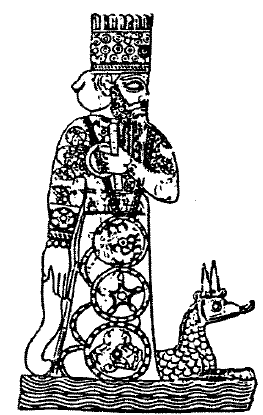|
I - Alexander’s Quest for Immortality
His military forces, with some 15,000 elite foot soldiers and cavalry, represented an alliance of Greek states formed in response to repeated invasions of Greece by the Asiatic Persians: First, in 490 B.C. (when the invasion was repulsed at Marathon) and then in 480/479 B.C., when the Persians humiliated the Greeks by occupying and sacking Athens.
While the Persians were organized in a mighty empire ruled by a succession of "King of Kings," the Greeks were fragmented into quarreling city-states; the devastating and humiliating Persian invasions coupled with the continuing clashes on land and sea finally served as an impetus to form a League under the leadership of Macedonia; and the task of leading the counterattack was entrusted to Alexander.
Carrying a copy of the epic tale given him by his tutor Aristotle, Alexander made it a point to stop at the ruins of Troy to offer sacrifices to the goddess Athena and pay homage at the tomb of Achilles (whose courage and heroism Alexander admired).
Figure 1
The Persians, rather than ward off the invaders at the beach, saw a chance to annihilate the Greek force by luring it inland.
A Persian army, led by one of their best generals, was waiting for Alexander and his army along a river, forming a battle line somewhat inland; but though the Persians had the advantage of positions and numbers, the Greeks broke through.
Falling back, the Persians assembled another army and even planned a counter-invasion of Greece; but in the meantime, their retreat enabled the Greeks to advance freely in Asia Minor, all the way to what is now the Turkish-Syrian border (‘B’ on map, Fig. 1).
The Persian king, beaten but not defeated, retreated to Babylon (‘C’ on map, Fig. 1) the western headquarters of an empire that stretched from Asia Minor (where Alexander had invaded) all the way to India.
Giving up the chance for a decisive victory, Alexander instead set his course southward...
Figure 2
The defeat of the Persians to avenge their previous attacks on Greece - the reason for the Greek states’ alliance under Alexander - was deferred to a later time.
It was Egypt, not Persia, the astounded Greek generals discovered, that was the real pressing destination for Alexander.
As related in various accounts, the court of King Philip was once visited by an Egyptian Pharaoh whom the Greeks called Nectanebus.
He was a master magician, a diviner, and he secretly seduced Queen Olympias, Philip’s wife; thus, though it was assumed when she gave birth to Alexander that it was King Philip who was the father, Alexander’s true father was an Egyptian visitor.
It was perhaps then, but certainly not later than when the king’s new wife was with child, that the story took another twist: The mysterious visitor who had presumably fathered Alexander was not a mere Egyptian - he was a god in disguise: the Egyptian god Amon (also spelled Ammon, Amun, Amen).
According to this version, Alexander was more than a royal prince (the queen’s son) - he was a demigod.
It was the location of ancient Greece’s most famed oracle to which kings and heroes went to consult about their future. There, in the temple to the god Apollo, a legendary priestess, the Sibyl, would go into a trance and, speaking for the god, would answer the visitor’s question.
What was clear, though, was the indication that Alexander would find the answer in Egypt - at that country’s most famous oracle site: The oasis of Siwa (‘D’ on map, Fig 1).
The two oracle sites were linked by legend and history. The one at Delphi - a name that meant "womb" in Greek - was said to have been chosen by Zeus, head of the Greek pantheon, after two birds he had sent from two opposite places on Earth met there.
Declaring the site to be a "navel of the Earth," Zeus placed there an oval-shaped stone called an Omphalus - Greek for "navel." It was a Whispering Stone by which the gods communicated, and according to ancient traditions it was the most sacred object in Apollo’s temple, and the Delphic Sybil sat on it when she pronounced her oracular responses.
(That original Omphalus stone was replaced in Roman times by a replica, Fig. 3a, which visitors to Delphi can still see.)
The main temple there was dedicated to the Egyptian god Amon, whom the Greeks considered to be the Egyptian ‘Zeus’.
It too had a Whispering Stone, an Egyptian omphalus (Fig. 3b); and it assumed a sacred place in Greek myth-cum-history because the god Dionysus, once lost in the Western Desert, was saved by being miraculously guided to the oasis. Dionysus was a half-brother of Apollo, and used to fill in for him in Delphi when Apollo was away.
Moreover - especially from Alexander’s viewpoint -
Dionysus attained the status
of a god although he was in reality a demigod - the son of Zeus who,
disguised as a man, had seduced a princess named Selene.
It was, in essence, an earlier occurrence akin to Alexander’s - a god in disguise fathering a son by a royal human female; and if Dionysus could be deified and become one of the Immortals - why not Alexander?
The legendary hero Hercules, famed for his challenging Twelve Labors, was also said to have consulted the Siwa oracle; not surprisingly, he too was a demigod, son of Zeus who had impregnated the wise and beautiful Alcmena, having disguised himself as her husband, the king of an island. The precedents clearly fitted Alexander’s own quest.
Except for the Phoenician stronghold of Tyre, whose navy participated in the war as Persia’s allies, the Greeks’ advance was hardly resisted: Alexander, by and large, was welcomed as a liberator from a detested Persian rule.
But Alexander insisted on fulfilling the directive of the Delphi oracle and embarked on the dangerous three-week desert trek to Siwa: He needed to hear the verdict about his immortality.
One version is that when it was over, Alexander said to his companions that he,
Another version reported that his divine parentage, though not a physical immortality, was confirmed - leading Alexander to henceforth pay his troops with silver coins bearing his image with horns (Fig. 4a), in the likeness of the horned god Amon (Fig. 4b).
A third version, supported by what Alexander did thereafter, is that he was instructed to seek out a certain mountain with subterranean passageways in the Sinai Peninsula for angelic encounters, and then proceed to Babylon to the temple of the Babylonian god Marduk.
Figure 4
In my previous books I have shown that ‘Ra-Amon’ established his new headquarters in Babylon in Mesopotamia - where he was known as Marduk, son of the olden god whom the Egyptians called Ptah and the Mesopotamians Enki.
The secret presumably revealed to Alexander was that his true father, the Unseen (= Amoti) god in Egypt, was the god Marduk in Babylon; for within weeks of learning all that, Alexander set out for distant Babylon.
The two armies met on the eastern side of the Tigris River, at a place called Guacamole (‘E’ on map, Fig. 1), near the ruins of the erstwhile Assyrian capital Nineveh (now in the Kurdish part of northern Iraq).
Rejecting a third peace offer from Darius, Alexander
marched on to Babylon; he reached the renowned city in the autumn of
331 B.C. and rode in through its magnificent Ishtar Gate
(reconstruction, Fig. 5;
having been excavated and reassembled, it is now on display in
Berlin’s Museum of the Ancient Near East).
The temple was a great ziggurat (step pyramid) at the center of Babylon’s Sacred Precinct, rising in seven precise astronomically defined stages (a reconstruction, Fig. 6). Wisely, Alexander let it be known ahead of time that he is coming to pay homage to Babylon’s national god, Marduk, and to restore Marduk’s defiled temple.
It had been a tradition for new Babylonian kings to seek legitimacy by having the deity bless them by grasping their extended hands.
But this Alexander could not attain, for he found the god lying dead in a golden coffin, his body immersed in special oils for preservation.
Figure 6
What chance, then, did he, Alexander, a demigod at best, have to avoid death?
As if determined to defy the odds, Alexander enlisted thousands of workmen to restore the Esagil, spending scarce resources on the task; and as he left to continue his conquests, he made it clear that he had decided to make Babylon the capital of his new empire.
By the morning of what we now date as June 10, 323 B.C., Alexander was dead - attaining immortality not physically, but by being remembered ever since.
Modern scholars do not doubt the existence of Alexander the Great, and have written endlessly about him and his times, ascertaining every detail thereof. They know that the great Greek philosopher Aristotle was Alexander’s teacher and mentor, have established Alexander’s route, analyzed the strategy of every battle, recorded the names of his generals.
But that respected scholars engage in that without an ounce of shame is amazing; for while they describe every aspect and twist in the Macedonian court and its intrigues, they laugh off the part that triggered it all - that of the belief in that court, by Alexander himself, by learned people in Greece - that a god could father a son by a female mortal!
And what do all of them depict?
Invariably - anthropomorphic gods, heroic demigods, and episodes from the so-called mythical tales (as this depiction of the god Apollo welcoming his father, the god Zeus, accompanied by other gods and goddesses, Fig. 7).
But if the subject is gods, it is classified as Myth; for who in his right scientific mind would believe, as the ancient Greeks (or Egyptians or Babylonians) did, that the gods were actual beings - omnipotent, sky-roaming, engaged in battles, scheming trials and tribulations for heroes - and even fathering those heroes by having sex with human females?
Figure 7
The tales were essentially the same^ all over the globe; and though the revered beings were named differently in different lands, the names in the diverse languages had by and large the same meaning: an epithet denoting a particular aspect of the named deity.
Indra, the great Hindu god of storms, attained supremacy by battling rival gods with exploding thunderbolts, just as Zeus had done (Fig. 8); and his name, spelled syllabically In-da-ra, was found in god lists of the Hittites in Asia Minor; it was another name for the Hittite chief deity, Teshub, the god of thunders and lightnings (Fig. 9a) - Adad ("Wind Stormer") to the Assyrian and Babylonians, Hadad to the Canaanites, and even in the Americas where, as the god Viracocha, he was depicted on the "Gate of the Sun" in Tiwanaku, Bolivia (Fig. 9b).
It is a list that can go on and on. How could
that be, why was it so?
Figure 8
Figure 9 Advancing through Asia Minor the Greeks passed imposing Hittite monuments; in northern Mesopotamia they came across the ruins of Assyria’s great cities - desolate, but not yet buried by the sands of time.
Everywhere, not only the deities names, but also the iconography, the symbols, were the same - dominated by the sign of the Winged Disk (Fig. 10), which they encountered in Egypt and everywhere else - even on the monuments of Persian kings as their supreme symbol. What did it represent, what did it all mean?
Soon after Alexander’s death, the conquered lands were split between two of his generals, for his rightful heirs - his four-year-old son and his guardian, Alexander’s brother - were murdered.
Figure 10
Ptolemy and his successors, headquartered in Egypt, seized the African domains; Seleucus and his successors, based in Syria, ruled Anatolia, Mesopotamia, and the distant Asian lands.
Both new rulers embarked on efforts to learn the full story of the gods and lands now under their control.
The Ptolemies, who also established the famed Library of Alexandria, chose an Egyptian priest, known as Manetho, to write down in Greek Egypt’s dynastic history and divine prehistory.
The Seleucids retained a Greek-speaking Babylonian priest, known as ‘Berossus’, to compile for them the history and prehistory of Mankind and its gods according to Mesopotamian knowledge. In both instances, the motives were more than mere curiosity; as later events showed, the new rulers sought acceptance by suggesting that their reigns were a legitimate continuation of dynastic kingships that stretched all the way back to the gods.
Until archaeological excavations begun before World War I brought to light its location and imperial extent, its existence was known only from the Bible - first from the biblical tale of the Tower of Babel, then from historical events recorded in the books of Kings and the Prophets.
Mar.duk (= ‘Son of the Pure Mound’) was the firstborn son of the Sumerian god Ea/Enki, whose domains were in Africa (where, I have suggested, they were worshipped as the gods Ra and Ptah, respectively).
But Marduk sought overall dominion by establishing his own ‘Navel of the Earth’ in Mesopotamia proper - an effort that included the failed ‘Tower of Babel’ incident.
Success finally came after 2000 B.C., when a resplendent Marduk (see illustration, next page) invited all the other leading gods to reside in Babylon as his subordinates.
After a decline that lasted some five centuries, a Neo-Babylonian empire rose again, lasting to the 6th century B.C. Its conquests included several attacks on Jerusalem and the destruction of its Temple in 587 B.C. by King Nebuchadnezzar II - fully corroborating the biblical tales.
It was those ruins of the ziggurat-temple that Alexander attempted to rebuild.
|
